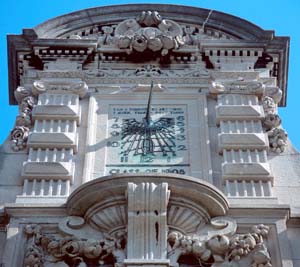While we are bombarded daily with gloomy stories about Earth going to a hot place in a handbasket, a group of roughly 45 enthusiasts from around the country are meeting in St. Louis, August 7-10, to celebrate the beauty of the Earth moving around the sun.
These enthusiasts are attending the 2008 Annual Conference of the North American Sundial Society (NASS), based out of Glastonbury, Conn. While meeting in St. Louis they will take a one-day tour on Friday, August 8, of 15 area sundials, some of historical importance, including one on the campus of Washington University in St. Louis that is marking its centennial anniversary. Donated to WUSTL by the class of 1908, one hundred years ago, the sundial faces south on the Cupples I building façade on the university’s Brookings Quadrangle. The motto on the sundial reads: I am a shadow/ So art thou/I mark time/Dost thou?

Sundials can be traced to antiquity and come in many designs. Some are elaborate and beautiful, others plain and practical, but all measure time by the position of the sun. Key components of sundials are a shadow-casting object called a gnomon and a surface with lines indicating the hours of the day and important dates. In a vertical sundial, such as WUSTL’s, the gnomon’s shadow casting edge, called its style, has to be aligned with the axis of the Earth’s rotation. To tell correct time, the style must point towards true north. The style’s angle with the vertical surface has to equal the sundial’s colatitude (90 degrees minus the latitude). The university’s colatitude is 51.4 degrees.
The core of these objects is a stew of mathematics and physics, and that is what appeals to Donald L. Snyder, Ph.D., senior professor of electrical and systems engineering and a NASS member who helped organize and arrange the tour for the conference.
Snyder sees sundials as physical realizations of mathematics.
“I’m interested in sundials because of their mathematical relation to the position of the sun at any time,” said Snyder, who has made a number of portable, wooden sundials of his own for family members. “It’s a thing of beauty to design an instrument on the basis of mathematics,the physics of solar and Earth motion and the effects of sunlight.
“Another reason I’m drawn to sundials is aesthetics. There are lots of artistic choices in designing and building one. Some are quite beautiful, such as Washington University’s.”
Snyder describes NASS members as by and large technical people including scientists and engineers and a few historians, especially of science. He is counting on several Junior Academy and Passport members of the Academy of Science of St. Louis to participate in the sundial tour.
Cahokia Mounds
There are two other sundials at WUSTL, one inlaid on a sidewalk between Crow Hall and the Earth and Planetary Sciences Building and the other in that building itself on a Mars rover-scaled replica. The sundial is in use yet on Mars with the rovers Spirit and Opportunity for color calibration for the rovers’ cameras.
On August 9, the NASS will offer numerous presentations on different aspects of sundials. One of them will be given by Michael W. Friedlander, Ph.D., professor of physics, who will discuss the excavation of Wood Henge, a solar calendar located at Cahokia Mounds State Historical Site, 20 minutes east of St. Louis in Illinois. Friedlander has analyzed the archaeological data obtained in excavations by the late Warren Wittry. This analysis confirms Wittry’s discovery of the astronomical significance of the site.
Cahokia is the site of an ancient city inhabited from about 700 to 1400 A.D with a peak population of perhaps 15,000. Numerous posts were set out around several circles with alignments to the sunrise positions at the solstices and equinoxes and what are considered to have been festival dates that related to the agricultural cycle of the region.
For the good times
On Earth, time is measured in three predominant fashions. Solar time, civil (or legal) time and hard time (the eight or so hours spent working, five days a week). Only solar time is truly scientific, said Snyder. While we are accustomed to thinking that the Earth takes 365 days to go around the sun, it actually takes about 365.25 days. Thus, every four years the quarter days add up to one whole day, and we have leap year. Despite our civil time units — 60 seconds, 60 minutes, 24 hours — it actually takes the Earth exactly 23 hours, 56 minutes and four seconds to make one revolution around its axis.
“Watches are compromises to accommodate the fact that there really aren’t 24 full hours in a day, and some days are shorter than others, but we have to have some standards,” Snyder said. “Whereas solar time depends upon where you are on the Earth, civil time results from dividing the Earth into 24 pieces — time zones — with each 15 degrees of longitude each representing an hour. Everybody within the 15 degrees has the same (civil) time.”
The group will view five sundials at the Missouri Botanical Gardens, including the only Islamic sundial in the country. Among others they will tour are sundials at the St. Louis Arsenal and Jefferson Barracks, dating back to the Civil War and functioning as the bases’ chronometers. They will see the Korean War Memorial sundial in Forest Park and one at the Missouri History Museum, a sundial designed by Thomas Jefferson that will be placed on special display by Shoenberg Curator Anne Woodhouse during the NASS tour for the participants and public to view.